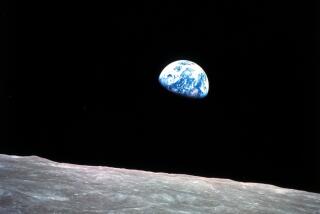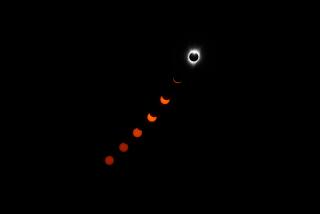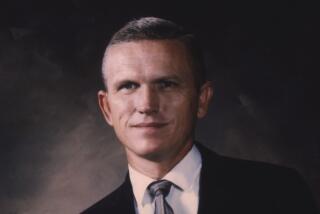For the Apollo crews, a small world
- Share via
‘We came all this way to the moon, and yet the most significant thing we’re seeing is our own home planet ...” Forty years after the first moonwalk, NASA has chosen to lead its anniversary coverage with Apollo 8 astronaut Bill Anders’ comment about the Earth. That fact alone shows how much the focus has changed since the first Space Age, when it seemed that everyone on Earth was looking outward into space. Ironically, what made the astronauts different was that they alone could look back home.
Even though it was there all the time (for the moon does not rotate), it wasn’t easy to see the distant Earth from the lunar surface. The astronauts’ visors gave them only a limited field of vision, and in any case they were kept busy for almost every minute -- the mission plans did not allow for sightseeing. “In the three days of exploration,” recalled Buzz Aldrin, the second man to walk on the moon, “there were a couple of times when I actually looked up to see the Earth -- and it was a difficult maneuver in that bulky suit.” Neil Armstrong, was kept awake at Tranquility Base by the Earth shining down through the onboard telescope “like a big blue eyeball”; it was so small that he could blot it out with his thumb. He was asked later if this made him feel big. “No,” he replied, “it made me feel really, really small.” Even on the moon, Armstrong identified with the Earth.
The very remoteness of Earth evoked powerful -- often spiritual -- feelings within the lunar travelers. As Michael Collins, the third member of the Apollo 11 crew, explained, while it was one thing to see the Earth from orbit, it was quite different “to actually be 100,000 miles out, to look out four windows and find nothing but black infinity, to finally locate the blue-and-white golf ball in the fifth window ...” He gazed on the jewel-like Earth with awe and wonderment, “suddenly aware of how its uniqueness is stamped in every atom of my body. Suddenly I knew what a tiny, fragile thing Earth is.”
Something similar had happened on Apollo 8, which the previous Christmas had carried out a pathfinder mission, flying around the moon without actually landing. Frank Borman, the commander, recalled his first sight of Earth from lunar orbit. “It was the most beautiful, heart-catching sight of my life, one that sent a torrent of nostalgia, of sheer homesickness, surging through me. It was the only thing in space that had any color to it.” A startling thought occurred to him: “This must be what God sees.”
The crew of Apollo 8, the first to orbit the moon, broadcast a prayer on the journey out and went on to read the creation story from the Book of Genesis in their Christmas broadcast. All this had an important influence on the Apollo 11 mission, when Aldrin performed his own Bible reading from space (“What is man, that thou art mindful of him?”). But more than this, in the quiet hours at Tranquillity Base between touchdown and moonwalk, Aldrin performed a one-man Holy Communion inside the lunar module, using a small silver chalice, a tiny vial of red wine and a wafer. Armstrong didn’t join in. “I just let him do his own thing,” he explained.
Astronauts drilled in technical procedures found it difficult to communicate their experiences on the moon and gained a reputation for dull language. Only later, in memoirs and interviews, did the full force of the experience emerge.
James Irwin of Apollo 15 wrote: “As we flew into space, we had a new sense of ourselves, of the Earth, and of the nearness of God.” He founded an evangelical organization called High Flight. Having discovered the 4-billion-year-old “genesis rock” on the moon, he went off to Mt. Ararat to look for Noah’s Ark. Edgar Mitchell of Apollo 14 had his own transforming experience and established an institute dedicated to expanding human consciousness.
Gene Cernan, who went to the moon twice, had his religious faith confirmed by the experience of seeing Earth as “the most beautiful star in the heavens.” “I have seen the endlessness of space and time with my own eyes,” he explained. (When she was 5, Cernan’s granddaughter realized that her grandfather was an astronaut. “I didn’t know you went to heaven,” she said.)
Alfred Worden of Apollo 15 became a poet, writing of Earth as “a distant memory seen in an instant of repose.” Al Bean, who accidentally burned out the camera on Apollo 12 by pointing it at the sun, became a painter. “My dream now is to create a body of paintings that tell the story of Apollo,” he explained. Stuart Roosa of Apollo 14 told his son how he would look at the Earth gleaming “like a jewel in the sky,” reflect on how it held everything he knew, and then marvel at how he could blot it out just by holding up his hand.
Above all, the astronauts were struck with how humanity needed to overcome its differences and care for its fragile planet. After seeing the Earth from afar, wrote Collins, “I determined in that moment that I would do all I could to let people know what a wonderful home we have -- before it is too late.” Perhaps the true legacy of Apollo is the environmental movement.
We have all seen the pictures, but in those distant Apollo years, 24 travelers saw the real thing: The whole Earth, hanging in space, visibly alive in a deserted cosmos. Almost without thinking about it, this band of test pilots achieved the dream of the philosophers of old: to behold the entire world.
Dick Gordon of Apollo 12 was often asked what we learned from going to the moon. His reply was simple: “We discovered the Earth.”
More to Read
Sign up for The Wild
We’ll help you find the best places to hike, bike and run, as well as the perfect silent spots for meditation and yoga.
You may occasionally receive promotional content from the Los Angeles Times.






